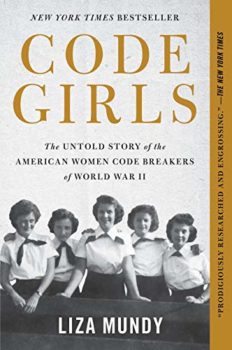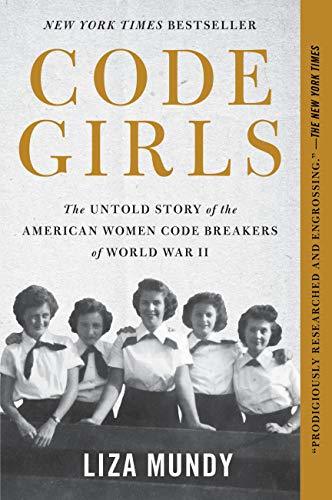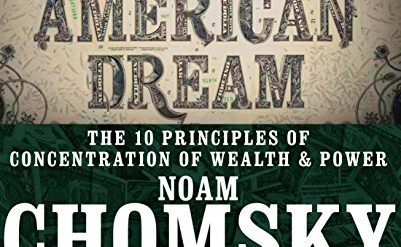
Estimated reading time: 7 minutes
It’s often said that winners write the history. And it’s true that until recently the winners in the gender wars—men—have written most of the history books. Only over the past few decades have the contributions of women begun to show up in published accounts of the past. Until just a few decades ago, a book like Code Girls would have been extremely unlikely to be published. Or, if it had reached print, to gain the wide audience it has.
The Enigma and Purple codes are only part of the story
If you’ve read much about how the Allies won World War II, chances are you’re familiar with two massive breakthroughs in signals intelligence: the British success in cracking the German Enigma code, and the American success with the Japanese Purple code.
With Enigma broken, the Allies were able to anticipate German troop movements, including Nazi preparations for the Normandy landing. The achievement didn’t produce a single dramatic Allied victory but contributed to victories in major ways on several fronts.
Breaking Purple made it possible for the US Navy to rout the Japanese at the Battle of Midway, which is often identified as the turning point in the Pacific War.
Code Girls: The Untold Story of the American Women Code Breakers of World War II by Liza Mundy (2017) 433 pages ★★★★★
The people most frequently credited with those two breakthroughs are the English mathematical genius Alan Turing and the celebrated American cryptographer William Friedman. Admittedly, those two accomplishments were extraordinary. Their impact was enormous. But they’re only part of the story. To place their achievements in context, read Liza Mundy’s brilliant account of the American women who worked on both projects.
During World War II more than 10,000 women worked on cryptography for the US Army and Navy in Washington, DC. They were sworn to secrecy about their work, and to this day some of those who survive, now in their 90s, are still reluctant to talk about it.
The amazing Code Girls who helped win World War II
As Mundy reveals in Code Girls, there were in fact not two but three breakthroughs in untangling Axis codes that were decisive, and most of those who worked on all three were women.
Breaking Enigma
Alan Turing did, indeed, lead the successful effort at Bletchley Park to defeat the supposedly unbreakable Engima code. But he didn’t work alone. Far from it. Ten thousand men and women worked at Bletchley Park, and many of them worked closely with Turing. Moreover, the Enigma machine was redesigned in February 1942, making it even more difficult to penetrate. It was American women working for the US Navy who broke that much more complex code. It was this breakthrough, not Turing’s, that enabled the Allies to locate and destroy German U-boats preying on the cross-Atlantic traffic. The British had never managed to read German naval communications.
Breaking Purple
When World War II broke out, William Friedman was already a legend in cryptographic circles. He wrote many of the textbooks in the field and played a leading role in organizing American codebreaking efforts. But the protracted search for a solution to Japan’s diplomatic code, Purple, involved hundreds of women. Several brilliant “girls” made contributions to the successful effort that were easily as impressive as those of the men they were working for. And it was women who identified the key to breaking a different Japanese code that enabled the Americans to shoot down the plane of Admiral Isoroku Yamamoto, the architect of the Pearl Harbor attack and the revered head of the Japanese Navy.
Breaking the Japanese shipping code
A third outsized achievement in cryptography that also played a strategic role in the Allies’ victory is rarely mentioned but was decisive in the Pacific. As Mundy notes, it “was one of the most important of the war. It was every bit as vital as the breaking of the Enigma or the Midway triumph.” The Japanese Navy had pressed huge numbers of civilian vessels into service to supply its bases and Japanese soldiers scattered throughout the seemingly boundless expanse of the Pacific Ocean. Code girls broke the communications system used on these ships that made it possible for the Americans to send submarines and airplanes to their locations. “More than two-thirds of the entire Japanese merchant marine and numerous warships . . . were sunk.” The impact of the resulting loss of food, ammunition, equipment, and personnel was devastating to the Japanese.
A singular achievement in popular history
Liza Mundy’s story of the code girls is difficult to put down. The extensive documentary research she conducted and her use of fifteen oral histories by code girls lends a wealth of intimate detail to the account. Dozens of women figure in the story, yet we feel close to them because of Mundy’s skill in bringing their day-to-day experiences to the surface. And we learn a great deal about the deplorable treatment of women during World War II, when millions were temporarily drawn into war work only to find themselves restricted to their homes once again after the war was won. Now, in the 21st century, it’s difficult to grasp just how deep-seated the sexism was back then. As Mundy reveals, “many Americans persisted in the view that military women were just prostitutes in uniform, admitted into the military to service the men.”
Mundy’s account of the bitter inter-service rivalry between the Army and Navy is also eye-opening. This involved a lot more than the annual Army-Navy game between West Point and Annapolis. The conflict between the two branches of the US military frequently led to avoidable inefficiency and sometimes to lost opportunities that might have been seized through cooperation.
Casting light on the vast scale of the codebreaking operations
Mundy also illuminates the massive scale of American codebreaking operations. For example:
- “Between 1943 and 1945, more than ten thousand Purple messages were delivered to American military intelligence.” Every one of those messages had to be painstakingly decoded by hand. There were no computers available to run complex algorithms that might do the job today.
- Similarly, in the fourth quarter of 1943 alone, naval code breakers received 126,000 messages per month transmitted in a different Japanese military code. Individual women (and some men) also had to tackle every one of those messages, one at a time.
- And the codebreaking operations couldn’t focus exclusively on the large numbers of German and Japanese codes. For example, the Navy’s codebreakers found themselves “working the codes of some twenty-five nations, enemy and neutral,” including those of such countries as Finland, Argentina, Ireland, and Liberia.
Those three examples illustrate the Navy’s challenges. The Army faced a similarly daunting task. Its “toughest assignment was breaking a fiendish tangle of Imperial Japanese Army codes, which were separate from those of the Imperial Japanese Navy.” And the Army met this challenge: “the breaking of all the Japanese Army codes—shipping, administrative, air force—contributed to the success of Operation Cartwheel, MacArthur’s island-hopping campaign.”
This book is a singular achievement in popular history. It’s not just the story of the Code Girls who helped win World War II. It’s a vivid portrait of American society during that all-important conflict.
For related reading
This is one of the 10 top WWII books about espionage.
I’ve also reviewed The Sisterhood: The Secret History of Women at the CIA by Liza Mundy (A deep dive into the history of women at the CIA).
Not long ago I reviewed The Woman Who Smashed Codes: A True Story of Love, Spies, and the Unlikely Heroine Who Outwitted America’s Enemies by Jason Fagone, which I greatly enjoyed as well. The book tells the amazing story of Elizebeth Smith Friedman, a celebrated codebreaker a generation older than the Code Girls of World War II but who was still active in their war. She appears in Mundy’s book as well. My review is at The woman codebreaker who caught gangsters and Nazi spies. And I’ve reviewed many other good books about Female spies and saboteurs in World War II.
I’ve reviewed many other books about the World War II era. You can find them listed and linked to my reviews at 10 top nonfiction books about World War II. You might also be interested in Top 20 popular books for understanding American history.
And you might also enjoy The 10 best novels about World War II.
And you can always find my most popular reviews, and the most recent ones, on the Home Page.


























